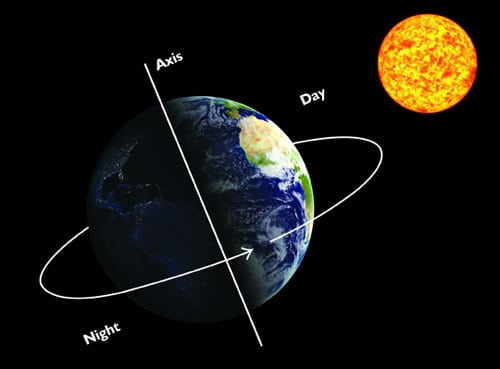Earth’s Orbit and Rotation and Creation of the Sun – Day 4 – Lesson 10 2024
Nehemiah 9:6 KJV
6 Thou, even thou, art LORD alone; thou hast made heaven, the heaven of heavens, with all their host, the earth, and all things that are therein, the seas, and all that is therein, and thou preservest them all; and the host of heaven worshippeth thee.
Earth’s Orbit
The Earth moves in two different ways. Earth orbits the sun once a year and rotates on its axis once a day.
The Earth’s orbit makes a circle around the sun. At the same time the Earth orbits around the sun, it also spins. It is referred to as rotating on its axis. Since the Earth orbits the sun AND rotates on its axis at the same time we experience seasons and day and night.
The Earth is always moving. Each day, the Earth makes one complete rotation on its axis. The axis is the imaginary line through the earth that extends from the North Pole to the South Pole.
As Earth rotates, it seems like the sun is moving across the sky, but it’s really the Earth that is spinning. It takes 24 hours to complete one rotation, which is why there are 24 hours in one day.
For example, if the sun is visible in the morning starting around 6:00 AM, the Earth will spin completely around by the next morning at 6:00 AM and you will see the sun in about the same place.
While the Earth is rotating on its axis, it also orbits the sun. It takes a little more than 365 days for the Earth to make a complete trip around the sun.
Other planets have different orbital times. It takes only 87 days for Mercury to orbit the sun, but 12 years for Jupiter to make the journey.
The light from the sun shines on half of the Earth at any given time. That side is warmer and brighter. The other side of the Earth faces away from the sun (it’s dark), so it is cooler and darker. Since the Earth is always spinning, there is a line between day and night that we pass through each day.
It is important to remember that the sun doesn’t travel across the sky. It looks that way because the Earth is spinning.
Genesis 1:14-19 KJV
14 And God said, Let there be lights in the firmament of the heaven to divide the day from the night; and let them be for signs, and for seasons, and for days, and years:
15 And let them be for lights in the firmament of the heaven to give light upon the earth: and it was so.
16 And God made two great lights; the greater light to rule the day, and the lesser light to rule the night: he made the stars also.
17 And God set them in the firmament of the heaven to give light upon the earth,
18 And to rule over the day and over the night, and to divide the light from the darkness: and God saw that it was good.
19 And the evening and the morning were the fourth day.
THE GREATR LIGHT
The Sun is a star. It is extremely important for life on Earth. The sun provides us with energy, which brings life on our planet. It defines the seasons, the harvests, and even the sleep patterns of all living creatures on Earth.
The sun is as old as God’s Word, the Bible, teaches us. The sun was created on Day 4 of God’s Creation Week which according to Scripture occurred between 6,000 and 7,000 years ago.
The sun is the closest star to our planet. That explains why we see the sun so big and bright. It is simply the nearest star to Earth.
The sun is much bigger than the Earth. In fact its radius is 109 times bigger than the radius of the Earth. For those of you who are curious, the sun’s Radius is 696,000 km and the Earth’s radius is 6,376 km.
DON’T TOUCH THE SUN! IT’S HOT! According to a report by NASA, the temperature at the Sun’s core is roughly 27 million degrees Fahrenheit and its surface temperature is 10,000 degrees Fahrenheit.
We know that the Earth’s structure consists of different layers. The sun also has layers, seven inner and outer layers, but, unlike the Earth, the sun is entirely gaseous; there is no solid surface.
The sun is 93 million miles away from the Earth.
The sun rotates on its axis approximately once every 26 days. The sun is made of gas, which is why it’s different parts rotate at different speeds. The fastest rotation is around the equator and the slowest rotation is at the sun’s polar regions (more than 30 days).
The sun changes. No matter when or where we look at the sun, we will always see something interesting. Scientists observe these changes by watching the sunspots. They increase and decrease on a regular cycle of about 10.8 years.
A solar eclipse occurs when the Moon is between the Sun and the Earth.
The Sun-“the greater light to rule the day”
From the rising of the sun to its going down. The LORD’s name is to be praised. Psalm 113:3
Next week Day 4 of Creation continues with discussion of Earth’s Moon, and of Stars and Galaxies.
